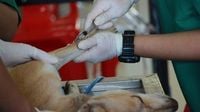In a world where rabies remains one of the deadliest diseases known to medicine, the story of Sai Kiran, a 17-year-old from Telangana’s Rajanna Sircilla district in India, stands out as a rare beacon of hope. Against all odds, Sai survived rabies—a disease that is almost universally fatal once symptoms begin—and has made a remarkable recovery, challenging long-held beliefs about the illness and shining a light on the urgent need for prevention, awareness, and research.
Sai’s ordeal began in 2018, when he was bitten by a dog near his home as he returned from school. Like so many others in India, Sai’s family faced immediate obstacles: the local government hospital had run out of anti-rabies vaccines. “The govt hospital in our neighbourhood ran out of anti-rabies vaccines,” his father, Raja Reddy, recounted to The Times of India. Sai received his first vaccination only two days after the bite, but the course could not be completed. Within weeks, he started showing classic rabies symptoms—photophobia (sensitivity to light), aerophobia (fear of air currents), and difficulty walking. He soon slipped into a coma, requiring mechanical ventilation, and his family was left heartbroken and desperate.
For three months, Sai lay in a deep coma, immobile and incontinent. His parents, determined not to give up, took him to various hospitals, tried every possible medicine and therapy, and even sold their property to cover the Rs 12 lakh in medical expenses. “We sold our property and spent Rs 12 lakh for his treatment, but it was worth it. Sai is off medications now. He walks to school on his own,” his father said, reflecting on the family’s sacrifice and Sai’s progress.
What makes Sai’s case so extraordinary is not just his survival, but the extent of his recovery. According to Dr Reeta Mani, professor and head of neurovirology at the National Institute of Mental Health and Neurosciences (NIMHANS) in Bengaluru—a WHO collaborative centre for rabies—Sai is a unique rabies survivor. “So far, only about 30 people worldwide are known to have survived rabies, and 17 of them are from India. But most of these survivors remain in a vegetative state or have severe disabilities. We can’t really consider that a recovery, because they don’t get their normal life back,” Dr Mani told The Times of India.
Yet Sai, now a Class IX student, has regained much of his independence. He is able to walk to school, look after himself, and has shown significant cognitive improvement. Dr Lokesh Lingappa, consultant child and adolescent neurologist at Rainbow Children’s Hospital in Hyderabad, who initially treated Sai, expressed his astonishment: “This kind of stability is unexpected in a patient who had rabies. None of the rabies survivors I’ve come across in my practice have gone back to school. I’ve seen children with just a small scratch bite develop symptoms of rabies and die in no time. There are very few survivors in the country or in the world who are as intact as this child.”
Hand bites, like the one Sai suffered, are considered grade 3—the most severe—because the dense network of nerves in the hands allows the rabies virus to travel quickly to the brain. Sai’s recovery, therefore, defies medical expectations. Dr Lingappa noted, “He received the anti-rabies vaccination two days after he got bitten, and then local immunoglobulin as well, which would have offered some protective effect.” A common thread among rabies survivors is that they were young, healthy before infection, and received some form of vaccination, even if incomplete. “Most survivors had antibodies in both their blood and cerebrospinal fluid, even though the virus was not detectable. This suggests that their immune system put up a fight against the virus,” Dr Mani explained.
India, home to 57% of the world’s rabies survivors, also records the highest number of rabies cases globally. The first documented case of a rabies survivor in India was reported in 2000, and since then, more cases have emerged, though most survivors have not fully recovered. The human toll is immense—not just in suffering, but in economic hardship, as families are often pushed into bankruptcy by the costs of treatment. “It is very traumatic for families to see a loved one in a vegetative state. Moreover, medical costs push them into bankruptcy,” Dr Mani emphasized.
The situation is not unique to India. In South Africa, the Department of Agriculture has called for increased awareness and vaccination efforts ahead of World Rabies Day on September 28, 2025. Minister of Agriculture John Steenhuisen urged communities to unite behind this year’s theme, “Act now: You, me, community,” to fight rabies. “Rabies remains one of the deadliest but most preventable diseases. On World Rabies Day, we recommit to vaccination, awareness, and community partnerships that protect both human and animal health. Together, we can end rabies deaths in South Africa,” Steenhuisen said, according to Food For Mzansi.
Rabies continues to be a significant threat across all nine provinces in South Africa, with hotspots in Limpopo, KwaZulu-Natal, Eastern Cape, and the Free State/Lesotho border. In 2024, South Africa reported 344 laboratory-confirmed animal rabies cases and eight human cases. Between January 1 and September 9, 2025, there were 242 animal cases and nine confirmed plus two probable human cases. So far in 2025, eleven human rabies deaths have been recorded—each one preventable through vaccination and awareness.
Dr Mpho Maja, director of animal health at the Department of Agriculture, highlighted the need for community collaboration: “The best way to eat an elephant is one bite at a time. Each one of us can make a small, consistent and deliberate effort (one bite), which will collectively result in eradicating dog mediated human rabies by 2030.” Dr Maja stressed that responsible pet ownership, community education, and timely vaccination are the keys to breaking the domestic dog cycle of rabies and protecting families.
The science is clear: rabies is 99.9% fatal once clinical signs appear, but it is also 100% preventable through vaccination of pets and timely post-exposure prophylaxis in humans. Post-exposure treatment involves thoroughly washing the wound with soap and water, followed by a series of rabies vaccinations and immunoglobulin if the skin has been broken. The vaccination schedule for pets starts at 12 weeks of age, with boosters required regularly—annually in high-risk areas.
Legal mandates in South Africa require every pet owner to vaccinate their dogs and cats, forming a protective barrier for both humans and animals. “Through responsible pet ownership, learning more about rabies, creating awareness within our inner circles, educating others, and taking action within our communities, we contribute to a society safe from rabies. Stay informed, stay vigilant, ensure your pets are vaccinated and talk about the importance of rabies prevention,” Dr Maja urged.
Despite the progress in some cases, effective treatment for rabies remains elusive. The Milwaukee Protocol, developed in 2004 by Dr Rodney Willoughby in the United States, is one experimental approach that involves inducing a coma and administering antiviral drugs to give the immune system time to respond. However, as Dr Mani notes, “Ultimately, it is the patient’s immune response—sometimes helped by prior vaccination or the infecting virus—that can make the difference in survival.” Research into gene therapy and monoclonal antibodies continues, offering hope for more accessible and scalable treatments in the future.
As the world marks World Rabies Day, Sai Kiran’s story is a testament to the power of determination, the resilience of the human body, and the importance of vaccination and awareness. His journey underscores both the tragedy and the hope that define the fight against rabies—a fight that, with collective action and scientific innovation, could one day be won.




